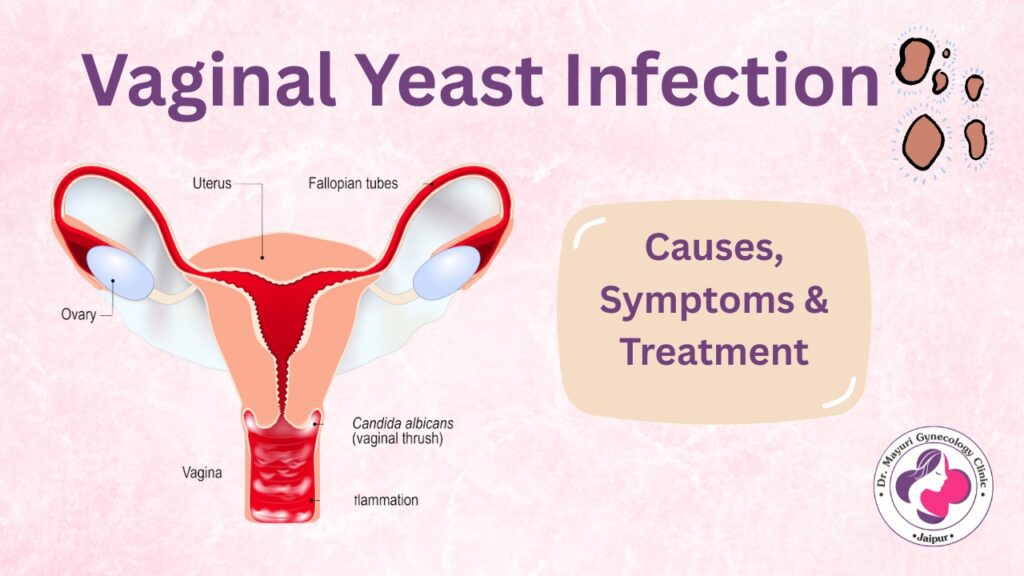Vaginal Yeast Infection: Causes, Symptoms & Treatment

Vaginal yeast infections are a widespread issue that many women encounter at various points in their lives. While it’s usually not a serious or life-threatening condition, it can cause discomfort, irritation, and emotional stress if not addressed properly. Many women feel embarrassed or confused about the symptoms and treatment, especially when dealing with it for the first time.
In this comprehensive guide, we’ll explain in simple, easy-to-understand language what a vaginal yeast infection is, why it happens, how to recognize its symptoms, and the best treatment options available. With the right knowledge and care, vaginal yeast infections can be managed effectively, allowing you to stay healthy, confident, and comfortable in your daily life.
What is a Vaginal Yeast Infection?
Also known as vulvovaginal candidiasis, a vaginal yeast infection occurs when the fungus Candida, primarily Candida albicans, overgrows in the vaginal region. Normally, this fungus is present in small amounts and lives in balance with healthy bacteria like Lactobacillus, which keep it in check.
When the natural balance is disrupted, Candida can multiply excessively, causing an infection. Although uncomfortable, this condition is not classified as a sexually transmitted infection (STI). Many women experience it once or more in their lives, especially between puberty and menopause.
Causes of Vaginal Yeast Infection
A yeast infection arises from an imbalance in the natural flora of the vagina, allowing the Candida fungus to grow excessively. Here are some of the primary causes and contributing factors linked to this condition.
1. Use of Antibiotics
Antibiotics used to treat other infections can kill both harmful and beneficial bacteria. This reduces the population of protective bacteria, allowing Candida to overgrow unchecked.
2. Hormonal Changes
Hormonal fluctuations can disrupt the vaginal environment. These changes occur during:
- Pregnancy (due to higher estrogen levels)
- Menstruation
- Breastfeeding
- Menopause
- Use of birth control pills or hormone replacement therapy
3. Uncontrolled Diabetes
High blood sugar levels provide nourishment for Candida, allowing it to thrive. Women with poorly controlled diabetes are more prone to recurrent yeast infections.
4. Weakened Immune System
Health conditions such as HIV/AIDS, cancer treatments, or long-term use of steroids can weaken the immune system, making it harder for the body to regulate fungal growth.
5. Wearing Tight or Non-Breathable Clothing
Clothing made from synthetic materials, tight jeans, or wet swimsuits can create warm, moist environments ideal for yeast growth. This issue is particularly prevalent in hot and humid climates.
6. Poor Hygiene or Harsh Products
- Using scented tampons, douches, or sprays
- Washing with harsh soaps or chemicals
- Failing to change sanitary pads or cloths regularly
These habits can upset the natural bacterial and yeast balance in the vagina.
7. High Sugar Diet
Eating foods rich in sugars and refined carbohydrates feeds yeast, promoting its growth in the vaginal area.
8. Sexual Activity
Though not classified as an STI, sexual activity can introduce bacteria or yeast from a partner, especially during oral-genital contact, increasing the risk of infection.
9. Stress and Fatigue
Prolonged stress weakens the immune response, giving Candida an opportunity to grow unchecked.
10. Other Factors
- Wearing damp or sweaty clothes for long periods
- Not drying thoroughly after bathing
- Using certain medications that suppress the immune system
Symptoms of Vaginal Yeast Infection
The symptoms of a yeast infection can vary from mild irritation to intense discomfort, and noticing them early can lead to prompt treatment. Here are all the common symptoms:
✅ Intense Itching and Irritation
One of the earliest and most troubling symptoms is itching in the vaginal and vulvar area, which can be constant and interfere with daily activities.
✅ Thick White Discharge
A cottage cheese-like, thick, white discharge that is usually odorless is a hallmark sign of yeast infection.
✅ Redness and Swelling
Redness and swelling may occur as the vaginal tissues become inflamed, causing them to appear red, tender, and swollen.
✅ Burning Sensation
You may experience burning during urination or sexual intercourse because of irritated tissues.
✅ Pain During Intercourse (Dyspareunia)
The inflammation may cause discomfort or pain during penetrative sex.
✅ Small Cuts or Cracks in the Skin
Severe itching and inflammation may lead to tiny fissures or cuts around the vaginal area.
✅ Watery Discharge
Though less common, some women experience a watery discharge alongside other symptoms.
✅ Vaginal Rash
A rash with redness, bumps, or blisters may develop on the vulva, causing itching and discomfort.
✅ Pain or Discomfort During Urination
Urination can become painful as urine passes over inflamed areas.
✅ Recurrent Infections
Experiencing four or more yeast infections a year may be linked to underlying conditions like uncontrolled diabetes or a weak immune system.
Treatment of Vaginal Yeast Infection
Vaginal yeast infections are common, but the good news is that they are treatable with proper care and medications. Based on how severe the infection is and the individual’s health condition, doctors may suggest different treatment methods. Here is a step-by-step guide to managing this condition effectively.
Step 1 – Recognize the Symptoms
Before starting treatment, It is important to recognize symptoms such as:
- Intense itching and irritation in the vaginal area
- Thick, white, odorless discharge that looks like cottage cheese
- Redness, swelling, or soreness around the vulva
- Burning sensation during urination or sexual intercourse
Once these symptoms are noticed, treatment can begin promptly.
Step 2 – Consult a Healthcare Provider
Mild infections can sometimes be treated at home, but it is essential to see a doctor if:
- It’s your first infection
- The symptoms are severe or worsening
- You are pregnant
- You have uncontrolled diabetes or a compromised immune system.
- The infection keeps recurring
A doctor will confirm the diagnosis and recommend the best treatment based on your symptoms and medical history.
Step 3 – Choose the Right Treatment Option
A. Over-the-Counter (OTC) Antifungal Medications
These are suitable for uncomplicated infections and include:
- Creams and ointments (e.g., clotrimazole, miconazole): Apply externally on the affected area to reduce itching and burning.
- Vaginal suppositories or tablets: Insert into the vagina using an applicator for direct action against the fungus. Treatment usually continues for a period ranging from three to seven days.
Always follow the instructions on the medication packaging and take the proper dosage.
B. Prescription Antifungal Treatments
Prescription antifungal treatments may be advised for more severe or recurring infections, including stronger medications such as:
- Oral antifungal tablets (e.g., fluconazole): Often given as a single dose, but severe cases may need multiple doses.
- Prescription-strength vaginal creams (e.g., terconazole or butoconazole): Used daily for 3 to 7 days or longer depending on the severity.
Step 4 – Special Treatments for Severe or Chronic Infections
A. Extended Therapy
A longer treatment course may be necessary if the infection is particularly stubborn or recurrent.
- Multiple doses of fluconazole spread over a few weeks
- Combination therapy with oral and topical treatments
B. Maintenance Therapy
For women who experience frequent infections (four or more times a year), doctors may recommend:
- Weekly fluconazole tablets for several months
- Long-term use of antifungal creams or suppositories
This helps prevent recurrence and keeps the infection under control.
Step 5 – Follow the Treatment Properly
- Complete the full course – Even if symptoms disappear after a few days, finishing the entire course ensures the infection is fully treated and prevents it from returning.
- Avoid self-medicating – Using leftover medicine or home remedies like garlic, curd, or oils may cause more harm than good.
- Avoid sexual activity during treatment – Sexual intercourse can worsen irritation, and certain medications can weaken condoms and diaphragms, making them less effective.
- Check for interactions – Some medications like fluconazole can interact with others, so always consult your healthcare provider before starting treatment, especially if you’re on other prescriptions.
Step 6 – Special Considerations
For Pregnant Women
- Use topical creams or suppositories rather than oral medications to ensure safety for both mother and baby.
For People with Diabetes or Weakened Immunity
- It is essential to monitor and manage blood sugar levels.
- Extended or maintenance treatments may be necessary to avoid frequent recurrences.
For Severe Infections
- A 14-day course or multiple doses may be prescribed.
- Regular medical check-ins are vital to ensure you recover fully and safely.
Step 7 – Prevention Tips During and After Treatment
- Wear breathable cotton underwear.
- Avoid synthetic, tight clothing and damp environments.
- Practice good hygiene but avoid harsh soaps and scented products.
- Manage diet and reduce sugar intake.
- Keep stress under control through relaxation and adequate sleep.
- Seek medical advice promptly if symptoms return.
Conclusion
A vaginal yeast infection is a common but treatable condition. While the symptoms can be uncomfortable and sometimes embarrassing, knowing the causes and signs helps in managing it effectively. With proper hygiene, medical care, and lifestyle adjustments, most women can prevent and treat this infection without complications.
If you notice symptoms or are unsure about your condition, reach out to a healthcare provider. Maintaining vaginal health is vital for overall comfort, confidence, and well-being.


